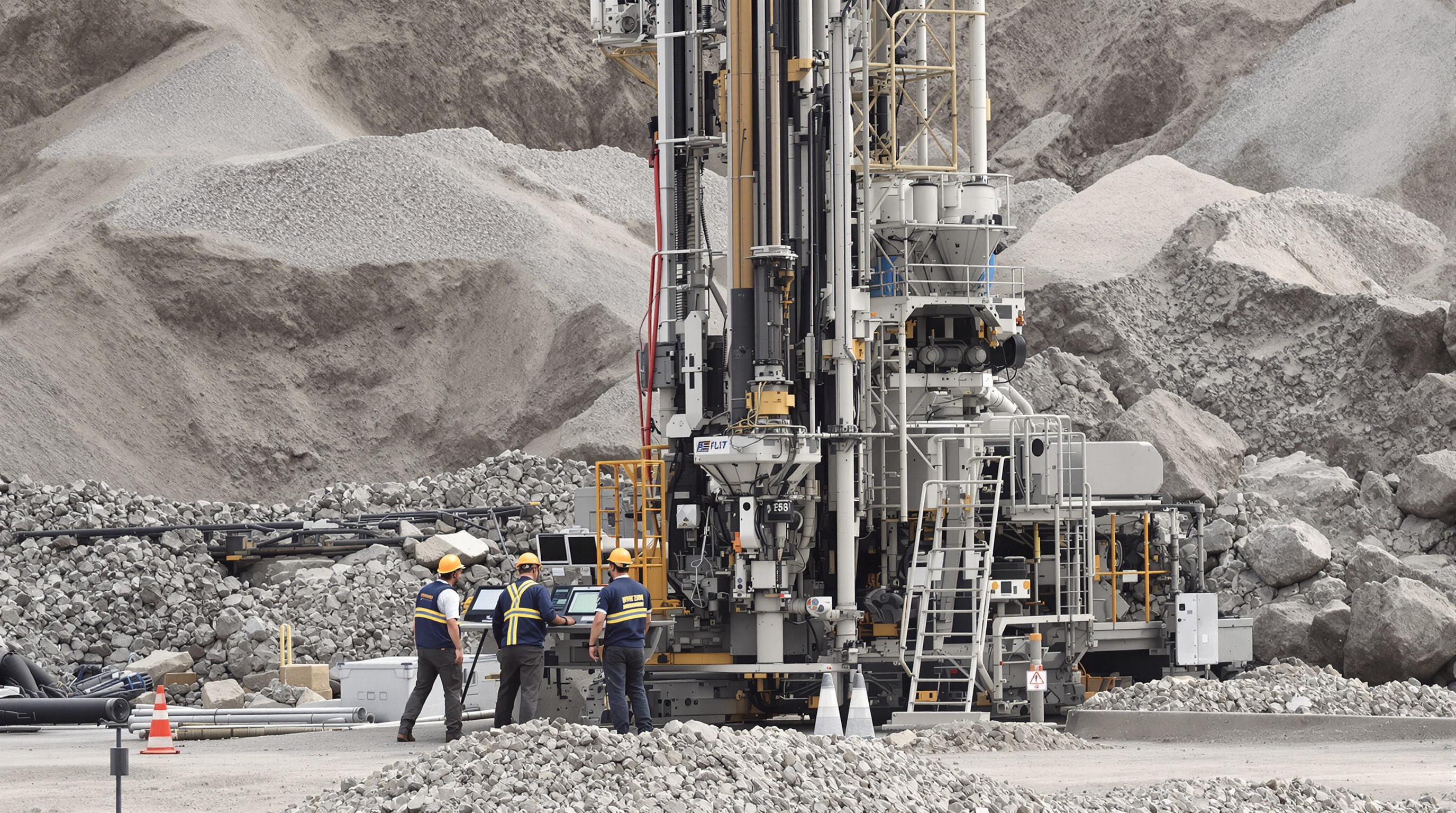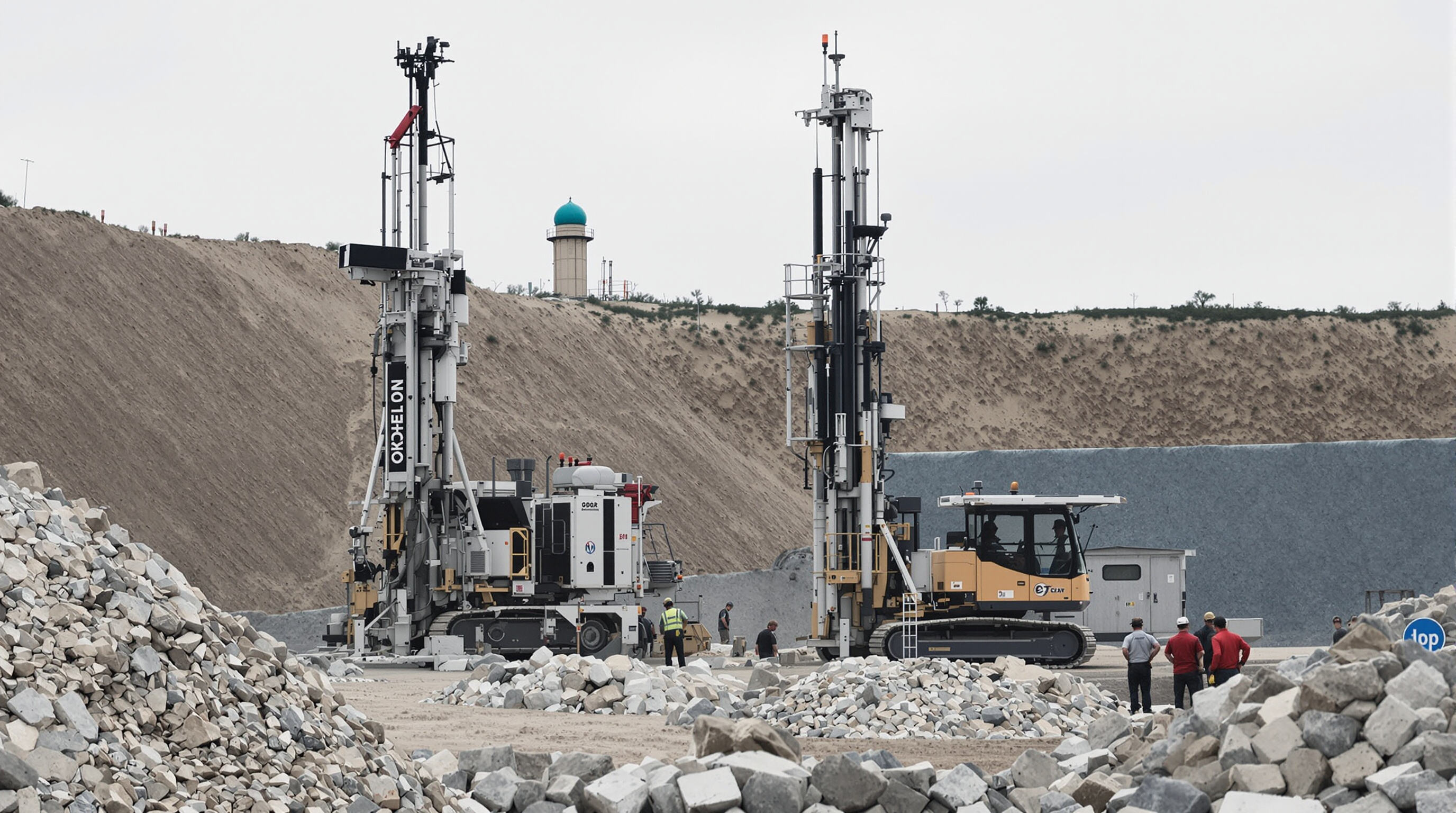How DTH Drill Rig Efficiency Transforms Performance in Hard Rock Conditions
The latest generation of DTH (Down-The-Hole) hammers is changing how we tackle tough rock drilling jobs. These tools send focused impact power straight to where it matters most at the drill bit, cutting through granite and basalt much quicker than traditional rotary techniques. Some field tests show penetration speeds jumping anywhere from 35 to almost 50 percent faster. According to market reports on global DTH drill rigs, better designed hammers cut down unexpected stoppages by around 22% when working in really abrasive materials. That makes all the difference for quarry operations trying to hit their monthly output goals. What's driving this improvement? Innovations such as smart air pressure adjustments help save fuel costs while still breaking up rock consistently across different formations. Operators are starting to notice these real world benefits in their day to day work.
Key Technological Advancements in DTH Drilling Systems

The shift toward automation and real-time monitoring separates modern DTH rigs from legacy equipment. Advanced rigs now integrate:
- Smart depth sensors for ±5 cm borehole accuracy
- AI-powered parameter optimization adjusting RPM and feed force dynamically
- Modular hammer assemblies slashing bit replacement time by 60%
According to the 2024 United States Down-The-Hole Drill Market report, these innovations have driven a 41% reduction in drilling costs per meter since 2020 in shale and limestone operations.
Integrated DTH Drill Rigs and Their Role in Ensuring Operational Consistency
When all the components come together in one system, hammer performance works much better with carrier mobility while also handling dust suppression effectively. The whole package actually cuts down on those frustrating productivity drops we usually see with separate equipment setups somewhere around 12 to maybe even 18 percent. This matters a lot during transitions between different drilling patterns or when moving through various rock layers. And let's not forget about centralized data logging either. This feature keeps things consistent from one shift to the next, which is really important if we want to maintain good quality blast holes in dimension stone quarries where precision counts so much.
Versatility of DTH Hammers Across Diverse Rock Types in Quarrying
From high-silica granite to fractured dolomite, DTH systems adapt through rapid bit configuration changes. Modern cross-bit designs maintain 85–90% drilling efficiency across Mohs 5–8 hardness ranges, outperforming traditional roller cones in transitional geology. This versatility enables single-rig deployment in quarries with mixed sedimentary and igneous deposits.
Boosting Drilling Efficiency and Quarry Productivity with Modern DTH Drill Rigs
Achieving Faster Drilling Speeds with Advanced Downhole Hammer Technology
According to research published in the International Journal of Rock Mechanics last year, modern Down-The-Hole (DTH) hammers can penetrate medium to hard rock about 40 percent faster than old fashioned rotary techniques. The reason? Better designed hammers now pack around 20 to 30 percent more punch while actually using 15 percent less compressed air. When we look at specifics, these high frequency models running at 1800 beats per minute work especially well when matched with quality drill bits. They cut down on wasted energy as they fracture through rock formations. In granite specifically, operators are seeing drilling rates hit roughly 15 meters per hour, which beats what older systems could manage by about 35 percent. This kind of improvement makes a real difference on job sites where time is money.
How Improved Drilling Efficiency Shortens Project Timelines and Increases Output
When drilling speeds go up, project timelines naturally get shorter. According to industry reports, quarries that have upgraded to these new DTH rigs are seeing their blasthole drilling finished about 30 percent quicker. That means they can squeeze in around three to five extra production runs each month. The real kicker though comes from all the time saved during maintenance periods. These modern rigs last anywhere from 250 to 300 operating hours before needing service, whereas older equipment typically needs attention every 150 to 200 hours. And let's not forget about fuel savings either. Operators report getting somewhere between 18 and 25 percent better fuel efficiency per meter drilled, which makes a big difference when calculating overall returns on capital investments.
Case Study: Productivity Gains in a Limestone Quarry Using High-Performance DTH Rigs
A Mediterranean limestone operation replaced legacy drills with modern DTH rigs featuring automated pressure compensation and real-time performance monitoring. Over 12 months, results showed:
- 42% faster bench drilling (18 vs. 12.7 meters/hour)
- 28% reduction in drilling costs per ton
- 19% fewer machine stoppages
This productivity boost enabled the quarry to increase annual limestone output by 140,000 metric tons without expanding workforce or equipment fleets.
Evaluating Cost-Effectiveness: DTH Drill Rigs vs. Conventional Drilling Methods

Reducing Drilling Costs in High-Volume Quarries Through DTH Efficiency
The latest DTH drill rigs can slash running costs by around 30% in big quarries because they drill faster and burn less fuel overall. A recent study from the International Journal of Rock Mechanics backs this up, showing that DTH systems actually drill about 40% quicker in medium to hard rock formations when compared against traditional rotary techniques. The bottom line? Fuel bills drop roughly 25% for every meter drilled. Plus, maintenance needs come down too since new hammer designs and tougher alloys last longer between services, cutting downtime by about 35%. Look at quarries handling over half a million tons each year. Most find that these cost reductions usually pay back the initial investment in equipment within just under two years, making the switch pretty attractive from both financial and operational standpoints.
Comparative Cost-Effectiveness of DTH Drilling Versus Traditional Techniques
Top hammer drilling just isn't efficient enough when dealing with fractured rock formations. The problem gets worse because operators end up needing about half again as many blast holes to get similar results from blasting operations. Down the hole (DTH) rigs fix this issue by keeping holes properly aligned and transferring energy consistently throughout the process. Granite quarry owners report saving between $18 and $22 on consumables for every meter drilled using these systems. A major equipment maker collected real world data showing that DTH technology achieves nearly perfect borehole straightness at 97%, while traditional methods only hit around 78%. This difference means far fewer times when workers have to go back and drill again, which saves both time and money in the long run.
Balancing Upfront Investment with Long-Term Operational Savings
While DTH drill rigs carry a 15–20% higher initial cost, their lifecycle savings average $740k over five years through:
- 60% lower bit replacement frequency due to optimized fluid flushing
- 27% reduced labor costs from automated depth and angle controls
- 42% fewer machine hours per ton of extracted material
This ROI profile makes DTH technology essential for quarries operating more than 200 drilling hours monthly, where every 10% efficiency gain preserves $120k–$150k annually in avoidable downtime.
Optimizing Key Operational Factors for Maximum DTH Drill Rig Performance
Optimizing Drill Rig Power and Operating Parameters for Peak Output
Getting the right balance between hydraulic pressure, rotational speed, and feed force makes all the difference when it comes to how well DTH drill rigs perform. Research indicates that when these settings are adjusted according to what kind of rock they're drilling through, especially hard stuff like granite, penetration rates go up anywhere from 18% to around 22%. For anyone running these machines day in and day out, investing in equipment with real time monitoring capabilities is really worth considering. Keeping airflow within the sweet spot range of about 15 to 25 cubic feet per minute while maintaining pressure somewhere between 18 and 25 bars helps extend the life of those expensive hammers and keeps holes straighter too. Nobody wants to deal with bent rods or misaligned bores after spending hours on site.
Selecting the Right Drill Bit for Specific Rock Types and Geological Conditions
Choosing the right drill bit makes all the difference when it comes to how productive drilling operations actually are. Some studies from quarries back in 2023 suggest that about forty percent of differences in drilling output can be traced right back to what kind of bit was used. Concave button bits tend to work really well when dealing with broken up limestone formations. On the other hand, those parabolic shaped bits help prevent that annoying balling effect we see in clay rich areas. When working through tough materials like quartzite or basalt, most experts recommend going with tungsten carbide inserts rated at around 90 HRC hardness or higher. And don't forget about heat either. The latest findings point towards thermal fatigue resistance being pretty important for making sure bits last longer in those super abrasive conditions where things get really hot down there.
Minimizing Downtime with High-Quality Drill Bits and Components
Standardized component replacement cycles reduce unplanned maintenance by 34% (Mining Tech Journal 2024). Recommended practices include:
- Thread inspection every 50 drilling hours
- Flushing system audits to prevent cuttings accumulation
- Starter rod replacement at ¾ of manufacturer-rated lifespan
High-yield alloys in drill pipes extend service life by over 200 hours in saline-heavy quarry environments.
System Synergy: How DTH Hammers, Bits, and Drill Pipes Work Together
Optimal energy transfer requires less than 4% variance between hammer impact frequency (1,800–2,200 BPM) and bit resonance characteristics. Misalignment wastes up to 19% of compressor output as heat, highlighting the importance of integrated component testing and compatibility.
Strategic Equipment Selection to Maximize ROI in Quarrying Operations
Matching DTH Drill Rig Capabilities to Quarry Scale and Production Demands
Picking out the correct DTH drill rig means matching what's on paper with what actually needs doing on site. For big granite quarries churning out tons of material daily, going for rigs that can handle 150 to 250 mm drill holes and reach depths beyond 30 meters makes sense. These specs strike a good balance between getting things done quickly and maintaining accuracy. According to research published last year by folks at the International Quarrying Association, operations that matched their rigs to quarry size saw around 18 percent boost in productivity compared to places where the equipment just didn't fit right. Smaller setups looking for versatility often go with modular systems instead. These allow adjustment of pressure between roughly 8 and 25 bars, which helps when dealing with different rock types across the property while still keeping operations running smoothly.
Performance Review: DTH Hammer Applications Across Quarrying and Mining
DTH hammers perform really well in all kinds of rock formations, whether it's soft limestone or tough abrasive basalt. Many top brands have started adding dual flush systems lately, which helps cut down on bit wear by around 40% when working through silica rich rocks according to Pike Research findings from last year. For those dealing with hard rock mining specifically, hammer bits reinforced with carbide last about 22% longer than regular ones. That means less frequent replacements and savings of roughly twelve thousand dollars annually per drilling rig. Looking at actual field results shows that properly optimized DTH systems can slash energy usage by as much as 15% during extended operations. The result? Significantly reduced costs for every meter drilled.
FAQ
What is a DTH drill rig?
A DTH (Down-The-Hole) drill rig is a type of drilling machine that uses a percussive hammer at the bottom of the hole, aimed at increasing penetration rates and efficiency during rock drilling operations.
How do DTH hammers improve drilling performance?
DTH hammers deliver impact energy directly at the drill bit, which increases penetration speed and efficiency, especially in hard rock formations like granite or basalt.
What are the benefits of integrating modern technology into DTH drill rigs?
Integrating modern technology such as automation, smart sensors, and real-time performance monitoring into DTH drill rigs enhances operational efficiency, reduces costs, and minimizes machine downtime.
How do modern DTH systems achieve better cost-effectiveness over traditional methods?
Modern DTH systems achieve better cost-effectiveness by reducing fuel consumption, improving penetration rates, and minimizing maintenance costs, which contribute to a lower overall cost per meter drilled.
What should be considered when selecting the right DTH drill rig for a quarry?
When selecting a DTH drill rig, it is important to consider the scale of quarry operations, desired production rates, rock hardness, and the rig's ability to accommodate specific drill hole sizes and depths.
Table of Contents
- How DTH Drill Rig Efficiency Transforms Performance in Hard Rock Conditions
- Key Technological Advancements in DTH Drilling Systems
- Integrated DTH Drill Rigs and Their Role in Ensuring Operational Consistency
- Versatility of DTH Hammers Across Diverse Rock Types in Quarrying
- Boosting Drilling Efficiency and Quarry Productivity with Modern DTH Drill Rigs
- Evaluating Cost-Effectiveness: DTH Drill Rigs vs. Conventional Drilling Methods
- Optimizing Key Operational Factors for Maximum DTH Drill Rig Performance
- Strategic Equipment Selection to Maximize ROI in Quarrying Operations
- FAQ

